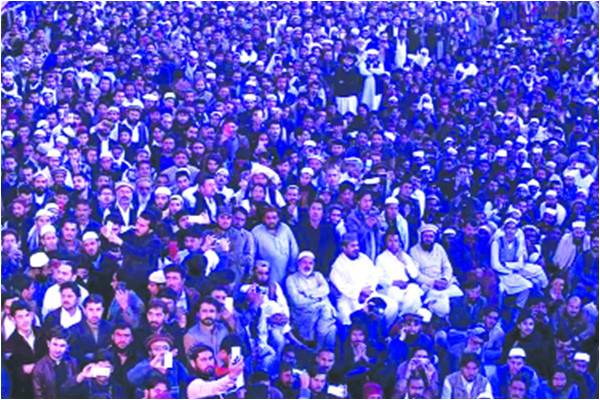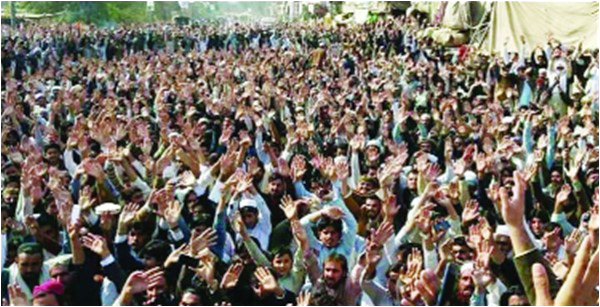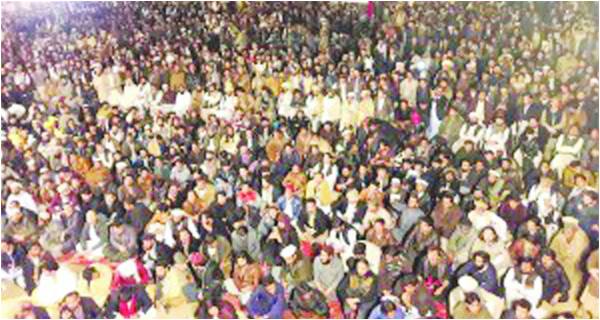
During negotiations, the director-general of the Inter-Services Public Relations, Major General Asif Ghafoor, asked why the army should talk to protestors who were shouting slogans against them. One of the young Pakhtun leaders replied: “For years, the protests and voices of the people of the Federally Administered Tribal Areas have been ignored. There is a lot of frustration. Let them have a few slogans.”
The controversial slogan in question is a popular one in leftist circles and protests. “Yeh jo dehshatgardi he, iskey peechey wardi he.” (This militancy you see, behind it is the uniform). But at the ten-day sit-in, popularly being called the Pashtun Long March, in front of the National Press Club in Islamabad, such slogans were met with a counter-slogan: “Long live the Pakistan Army!”

Peopled primarily by the Mehsud tribe of South Waziristan, the Pashtun Long March started from Dera Ismail Khan on January 26, led by 26-year-old Manzoor Ahmad Pashteen (Pashtun) and two dozen activists. And as the Mehsuds wound their way through Lakki Marwat, Bannu, Karak, Kohat and Dara Adam Khel to reach Peshawar, the numbers swelled.
The soundtrack to the march was, “Da sang Azadi da” or “What kind of freedom is this?” by South Waziristan’s young singer Shaukat Aziz. From Peshawar, 32-year-old Mohsin Javed Dawar joined with his group and via Charsadda, Mardan and Swabi, they reached Islamabad on February 1. Pashtun students and activists based in Islamabad added to the numbers, which were eventually estimated to be in the thousands. “Frankly, I didn’t think it would last more than a day,” Dawar says.
A march of tribal Pashtuns gave a vehicle of expression to Pashtuns all over Pakistan, driven by the young and fuelled by social media. It followed the playbook of other sit-ins; crowds would gather in the evenings, as speeches and slogans were made late into the crisp Islamabad night. Those who had homes, hostels, or relatives to go to would leave, others would sleep in a tent pitched outside the Islamabad Press Club. Peshawar Zalmi’s Javed Aziz Khan contributed a little for the meals. Others paid for the sound system. Thousands attended every day for ten days, as young Pashtuns, and leaders representing various political parties from Khyber Pakhtunkhwa too, brought their workers and spoke to the crowd.
The protesters had little patience with narrow political agendas. “When a Qaumi Watan Party leader campaigned for his candidate, the gathering booed. When a Pakistan Tehreek-e-Insaf leader started railing against the corruption of Zardari and Nawaz Sharif, they booed again,” says Mohsin Dawar.
The Islamabad Press Club lies a stone’s throw from an upscale market, and a few miles from the Red Zone, now blocked off with a permanent installation of rust-coloured containers, guarding the avenue leading to parliament like a row of bloodied teeth. It is on this avenue that the PTI and pro-Mumtaz Qadri or Barelvi groups held their sit-ins in 2014 and 2016, respectively.

The Pashtun Long March differed from other major protests over the last few years on more than just the choice of location—it was an organic upswell emanating from decades of frustration and expressed in the voices of multiple young activists rather than that of a single political party. Demands were based on human rights rather than political issues and are those which have so far left no destruction in their wake.
“It has now taken the shape of a spontaneous movement,” says Awami National Party’s former senator, Afrasiab Khattak. “There are tremors of unrest all over the country, and the epicenter is the tribal areas.” What was billed as the Mehsud Tahaffuz Movement has become a Pashtun Tahaffuz Movement—from the tribal to the nationalist, from the specific to the diffused.
Among the demands at the Islamabad dharna were the arrest of Karachi’s notorious ‘encounter specialist’ SSP Rao Anwar, the recovery of missing persons, compensation for the victims of military operations, an end to harassment at checkposts, and clearing of landmines. The dharna ended on Feb 10 after the civil and political leadership signed an agreement. Protestors have, however, given them a month to comply with the demands. Another rally has been planned in Quetta on March 10.
Had it not been for the young protestors’ insistence on a written agreement or a meeting with the army spokesperson, the demonstration would have in all probability ended with undocumented promises. The Mehsud tribal elders had packed up and left after meeting with the prime minister through a Maulana Fazlur Rehman intermediary. It was the army that responded to the young Pashtuns’ overtures. “There were more than a dozen of us, including a female activist,” says Nizamuddin Khan Salarzai, who was on the negotiating team. “The meeting lasted over four hours and led to more meetings with the commanders of two army divisions responsible for North and South Waziristan.”
Meanwhile, other demonstrations have erupted, in Bajaur, in Swat, in Zhob, in Kurrum, against the murder of a long march participant, and the indignities of going through multiple checkposts. In Swat, six protestors were booked for sedition and terrorism, cases that were withdrawn after the calls for another protest. The army chief has also retracted the ‘Watan card’, an identity card issued to displaced tribals during military operations, a symbol of ‘othering’.
The Pashtun Tahaffuz Movement’s leading icon is the 26-year-old Manzoor Ahmad Pashtun, who has been travelling in the north since the Islamabad protest in solidarity with other protests, rallying support, meeting with tribal elders, and to meet his family who he has not seen in months.
Manzoor was born in a village near the town of Sarwakai in South Waziristan. His father is a school teacher who loved books. “He would spend what little extra he had on books instead of fruit.” He is of a generation of young tribal Pashtuns that have known nothing but war, caught in the crossfire between the military and the militants and that has suffered the ache of displacement and stereotyping. “At schools in the settled areas, teachers and students would ask us how much we got paid for suicide bombings. It was painful.”
He was studying in Dera Ismail Khan in 2011 when he lost touch with his family for twenty days. He heard from relatives and friends that the village was being bombarded and his family had fled into treacherous mountain terrain.
He says it was only when while he was studying veterinary medicine in DI Khan’s Gomal University that he discovered political activism through student unions organized according to ethnic groupings. “Until then, I didn’t even know the names of the political parties in Pakistan,” he says. “But these unions just organized musical evenings, even as my people were being killed, harassed or disappeared.”
Manzoor, Mohsin and other young Pashtun leaders are in the process of compiling lists of enforced disappearances in the tribal areas. According to the Pashtun Tahaffuz Movement, there are now around 12,000 between 2002 to 2017, most under the age of 18. Mohsin cautions that the lists are not final yet, and they will be released soon, supported by evidence.
Manzoor’s long march from DI Khan to Islamabad had been planned before the ‘encounter killing’ of Naqeebullah Mehsud in Karachi, the photogenic shopkeeper from South Waziristan whose murder seemed to ignite a fire. Disparate groups of young tribal Pashtuns—protesting and organizing against the state’s excesses and brutalities or for the abolition of the Frontier Crimes Regulation in scattered parts of the country—found common cause.
Like Manzoor, other young leaders of the movement have witnessed the social, economic, political and cultural breakdown because of decades of militancy and military operations in the tribal areas, once described as “the most dangerous place in the world” by former US President Barack Obama.
In news and cultural tropes, tribal Pashtuns are either militants or victims—a Baitullah Mehsud or a Naqeebullah Mehsud. A new breed of displaced Pashtuns with varying political associations wants to accelerate change.
Nizamuddin Khan Salarzai is from Bajaur, heading the Pakistan Muslim League Nawaz’s Fata Youth Wing, one of dozens of youth groups under the umbrella of the Fata Youth Jirga formed in 2017 to advocate the merging of the tribal areas with KP. In 2006, his father was jailed under the draconian Frontier Crimes Regulations.
“There are no jobs in Fata, there is no education. In seven agencies and six frontier regions, there is not a single university, not a single engineering school or medical college,” he says. “All the kids need to study in Peshawar, DI Khan, Abbottabad, Kohat, Islamabad. When they came here, they realized what a normal life is like and then they return home and they have to queue up at checkposts, or if there is an attack on security personnel, the entire village is punished and arrested, men beaten up in front of their women.”
Thirty-two-year old Mohsin Javed Dawar is affiliated with the ANP. While Manzoor is from South Waziristan, Mohsin hails from North Waziristan and is a lawyer. “Tribal elders are only able to solve petty issues like helping people enter parts of Waziristan without permits. They don’t have the education or the exposure,” he says.
He speaks of the men he met at the long march from the Humzoni village in North Waziristan. They showed him marks of torture on their backs, punished allegedly by the military for being collaborators with the militants. Mohsin says they travelled to Islamabad because of anger. “If political parties had taken up these issues before, the anger would not have been so pent up. Even though political parties are more organized, have access to the corridors of power, they make political compromises for personal gain or with the security establishment.”
So too, does the mainstream media. If there is another defining feature of this new movement, it is that it has galvanized diaspora Pashtuns and amplified demands through the use of social media. Naqeebullah Mehsud’s killing followed the social media uproar over the rape and murder of six-year-old Zainab in Kasur. As Pashtun social media activists made a noise, there was another advantage. “Naqeeb’s case happened in Karachi where the media has access,” says Nizam. While tribal journalists are threatened by the militants and the military, mainstream media has little option but to be escorted by the military if it wants access to the tribal areas but this comes at the cost of journalistic independence and fact-checking.
Social media and scattered coverage in international media triggered a wave of solidarity in other countries too, such as the UK, Germany and Afghanistan. Indeed, Afghanistan’s President Ashraf Ghani’s series of tweets in support of the Pashtun Long March “to mobilise citizens against fundamentalism and terrorism in the region”, drew a sharp reaction from Pakistan’s foreign office as well as tribal elders, describing the statement as tantamount to interference in internal matters. But former senator Afrasiab Khattak doesn’t think so. “The Taliban are an anti-Pashtun project. Meanwhile our governments have been closing the border arbitrarily and Afghan trade has shifted to Chabahar. Who has suffered the most? Pashtun transporters and traders.”
Nizamuddin is, however, wary of calling this movement a #PashtunSpring. “More a political realization,” he says, that he hopes will also be self-sustaining.
The writer is a multimedia journalist. @AmberRShams
The controversial slogan in question is a popular one in leftist circles and protests. “Yeh jo dehshatgardi he, iskey peechey wardi he.” (This militancy you see, behind it is the uniform). But at the ten-day sit-in, popularly being called the Pashtun Long March, in front of the National Press Club in Islamabad, such slogans were met with a counter-slogan: “Long live the Pakistan Army!”

Peopled primarily by the Mehsud tribe of South Waziristan, the Pashtun Long March started from Dera Ismail Khan on January 26, led by 26-year-old Manzoor Ahmad Pashteen (Pashtun) and two dozen activists. And as the Mehsuds wound their way through Lakki Marwat, Bannu, Karak, Kohat and Dara Adam Khel to reach Peshawar, the numbers swelled.
The soundtrack to the march was, “Da sang Azadi da” or “What kind of freedom is this?” by South Waziristan’s young singer Shaukat Aziz. From Peshawar, 32-year-old Mohsin Javed Dawar joined with his group and via Charsadda, Mardan and Swabi, they reached Islamabad on February 1. Pashtun students and activists based in Islamabad added to the numbers, which were eventually estimated to be in the thousands. “Frankly, I didn’t think it would last more than a day,” Dawar says.
In news and cultural tropes, tribal Pashtuns are either militants or victims – a Baitullah Mehsud or a Naqeebullah Mehsud
A march of tribal Pashtuns gave a vehicle of expression to Pashtuns all over Pakistan, driven by the young and fuelled by social media. It followed the playbook of other sit-ins; crowds would gather in the evenings, as speeches and slogans were made late into the crisp Islamabad night. Those who had homes, hostels, or relatives to go to would leave, others would sleep in a tent pitched outside the Islamabad Press Club. Peshawar Zalmi’s Javed Aziz Khan contributed a little for the meals. Others paid for the sound system. Thousands attended every day for ten days, as young Pashtuns, and leaders representing various political parties from Khyber Pakhtunkhwa too, brought their workers and spoke to the crowd.
The protesters had little patience with narrow political agendas. “When a Qaumi Watan Party leader campaigned for his candidate, the gathering booed. When a Pakistan Tehreek-e-Insaf leader started railing against the corruption of Zardari and Nawaz Sharif, they booed again,” says Mohsin Dawar.
The Islamabad Press Club lies a stone’s throw from an upscale market, and a few miles from the Red Zone, now blocked off with a permanent installation of rust-coloured containers, guarding the avenue leading to parliament like a row of bloodied teeth. It is on this avenue that the PTI and pro-Mumtaz Qadri or Barelvi groups held their sit-ins in 2014 and 2016, respectively.

The Pashtun Long March differed from other major protests over the last few years on more than just the choice of location—it was an organic upswell emanating from decades of frustration and expressed in the voices of multiple young activists rather than that of a single political party. Demands were based on human rights rather than political issues and are those which have so far left no destruction in their wake.
“It has now taken the shape of a spontaneous movement,” says Awami National Party’s former senator, Afrasiab Khattak. “There are tremors of unrest all over the country, and the epicenter is the tribal areas.” What was billed as the Mehsud Tahaffuz Movement has become a Pashtun Tahaffuz Movement—from the tribal to the nationalist, from the specific to the diffused.
Among the demands at the Islamabad dharna were the arrest of Karachi’s notorious ‘encounter specialist’ SSP Rao Anwar, the recovery of missing persons, compensation for the victims of military operations, an end to harassment at checkposts, and clearing of landmines. The dharna ended on Feb 10 after the civil and political leadership signed an agreement. Protestors have, however, given them a month to comply with the demands. Another rally has been planned in Quetta on March 10.
The soundtrack to the march was, "Da sang Azadi da" or "What kind of freedom is this?" by South Waziristan's young singer Shaukat Aziz
Had it not been for the young protestors’ insistence on a written agreement or a meeting with the army spokesperson, the demonstration would have in all probability ended with undocumented promises. The Mehsud tribal elders had packed up and left after meeting with the prime minister through a Maulana Fazlur Rehman intermediary. It was the army that responded to the young Pashtuns’ overtures. “There were more than a dozen of us, including a female activist,” says Nizamuddin Khan Salarzai, who was on the negotiating team. “The meeting lasted over four hours and led to more meetings with the commanders of two army divisions responsible for North and South Waziristan.”
Meanwhile, other demonstrations have erupted, in Bajaur, in Swat, in Zhob, in Kurrum, against the murder of a long march participant, and the indignities of going through multiple checkposts. In Swat, six protestors were booked for sedition and terrorism, cases that were withdrawn after the calls for another protest. The army chief has also retracted the ‘Watan card’, an identity card issued to displaced tribals during military operations, a symbol of ‘othering’.
The Pashtun Tahaffuz Movement’s leading icon is the 26-year-old Manzoor Ahmad Pashtun, who has been travelling in the north since the Islamabad protest in solidarity with other protests, rallying support, meeting with tribal elders, and to meet his family who he has not seen in months.
Manzoor was born in a village near the town of Sarwakai in South Waziristan. His father is a school teacher who loved books. “He would spend what little extra he had on books instead of fruit.” He is of a generation of young tribal Pashtuns that have known nothing but war, caught in the crossfire between the military and the militants and that has suffered the ache of displacement and stereotyping. “At schools in the settled areas, teachers and students would ask us how much we got paid for suicide bombings. It was painful.”
He was studying in Dera Ismail Khan in 2011 when he lost touch with his family for twenty days. He heard from relatives and friends that the village was being bombarded and his family had fled into treacherous mountain terrain.
He says it was only when while he was studying veterinary medicine in DI Khan’s Gomal University that he discovered political activism through student unions organized according to ethnic groupings. “Until then, I didn’t even know the names of the political parties in Pakistan,” he says. “But these unions just organized musical evenings, even as my people were being killed, harassed or disappeared.”
Manzoor, Mohsin and other young Pashtun leaders are in the process of compiling lists of enforced disappearances in the tribal areas. According to the Pashtun Tahaffuz Movement, there are now around 12,000 between 2002 to 2017, most under the age of 18. Mohsin cautions that the lists are not final yet, and they will be released soon, supported by evidence.
Manzoor’s long march from DI Khan to Islamabad had been planned before the ‘encounter killing’ of Naqeebullah Mehsud in Karachi, the photogenic shopkeeper from South Waziristan whose murder seemed to ignite a fire. Disparate groups of young tribal Pashtuns—protesting and organizing against the state’s excesses and brutalities or for the abolition of the Frontier Crimes Regulation in scattered parts of the country—found common cause.
Like Manzoor, other young leaders of the movement have witnessed the social, economic, political and cultural breakdown because of decades of militancy and military operations in the tribal areas, once described as “the most dangerous place in the world” by former US President Barack Obama.
The protesters had little patience with narrow political agendas. "When a Qaumi Watan Party leader campaigned for his candidate, the gathering booed"
In news and cultural tropes, tribal Pashtuns are either militants or victims—a Baitullah Mehsud or a Naqeebullah Mehsud. A new breed of displaced Pashtuns with varying political associations wants to accelerate change.
Nizamuddin Khan Salarzai is from Bajaur, heading the Pakistan Muslim League Nawaz’s Fata Youth Wing, one of dozens of youth groups under the umbrella of the Fata Youth Jirga formed in 2017 to advocate the merging of the tribal areas with KP. In 2006, his father was jailed under the draconian Frontier Crimes Regulations.
“There are no jobs in Fata, there is no education. In seven agencies and six frontier regions, there is not a single university, not a single engineering school or medical college,” he says. “All the kids need to study in Peshawar, DI Khan, Abbottabad, Kohat, Islamabad. When they came here, they realized what a normal life is like and then they return home and they have to queue up at checkposts, or if there is an attack on security personnel, the entire village is punished and arrested, men beaten up in front of their women.”
Thirty-two-year old Mohsin Javed Dawar is affiliated with the ANP. While Manzoor is from South Waziristan, Mohsin hails from North Waziristan and is a lawyer. “Tribal elders are only able to solve petty issues like helping people enter parts of Waziristan without permits. They don’t have the education or the exposure,” he says.
He speaks of the men he met at the long march from the Humzoni village in North Waziristan. They showed him marks of torture on their backs, punished allegedly by the military for being collaborators with the militants. Mohsin says they travelled to Islamabad because of anger. “If political parties had taken up these issues before, the anger would not have been so pent up. Even though political parties are more organized, have access to the corridors of power, they make political compromises for personal gain or with the security establishment.”
So too, does the mainstream media. If there is another defining feature of this new movement, it is that it has galvanized diaspora Pashtuns and amplified demands through the use of social media. Naqeebullah Mehsud’s killing followed the social media uproar over the rape and murder of six-year-old Zainab in Kasur. As Pashtun social media activists made a noise, there was another advantage. “Naqeeb’s case happened in Karachi where the media has access,” says Nizam. While tribal journalists are threatened by the militants and the military, mainstream media has little option but to be escorted by the military if it wants access to the tribal areas but this comes at the cost of journalistic independence and fact-checking.
Social media and scattered coverage in international media triggered a wave of solidarity in other countries too, such as the UK, Germany and Afghanistan. Indeed, Afghanistan’s President Ashraf Ghani’s series of tweets in support of the Pashtun Long March “to mobilise citizens against fundamentalism and terrorism in the region”, drew a sharp reaction from Pakistan’s foreign office as well as tribal elders, describing the statement as tantamount to interference in internal matters. But former senator Afrasiab Khattak doesn’t think so. “The Taliban are an anti-Pashtun project. Meanwhile our governments have been closing the border arbitrarily and Afghan trade has shifted to Chabahar. Who has suffered the most? Pashtun transporters and traders.”
Nizamuddin is, however, wary of calling this movement a #PashtunSpring. “More a political realization,” he says, that he hopes will also be self-sustaining.
The writer is a multimedia journalist. @AmberRShams

